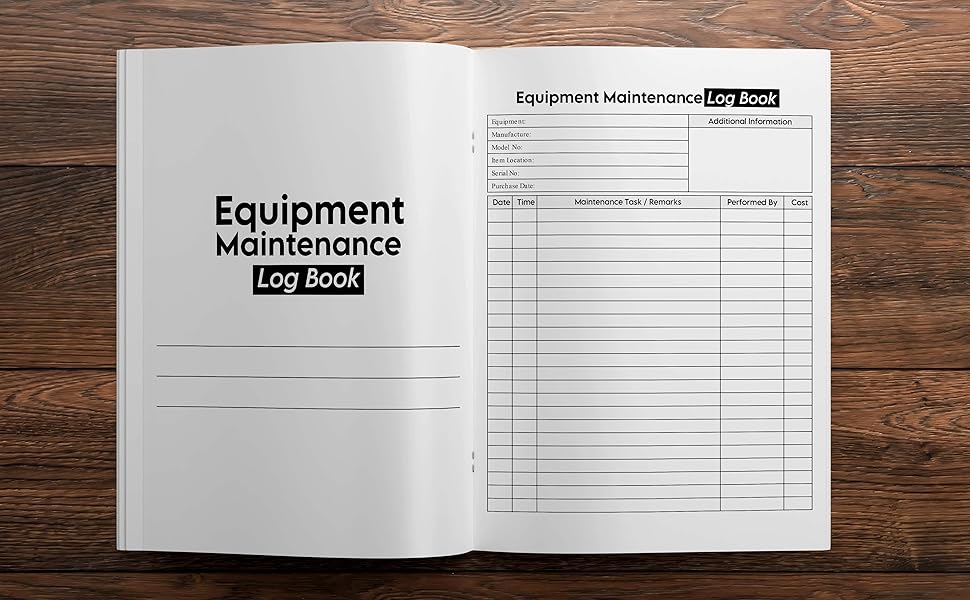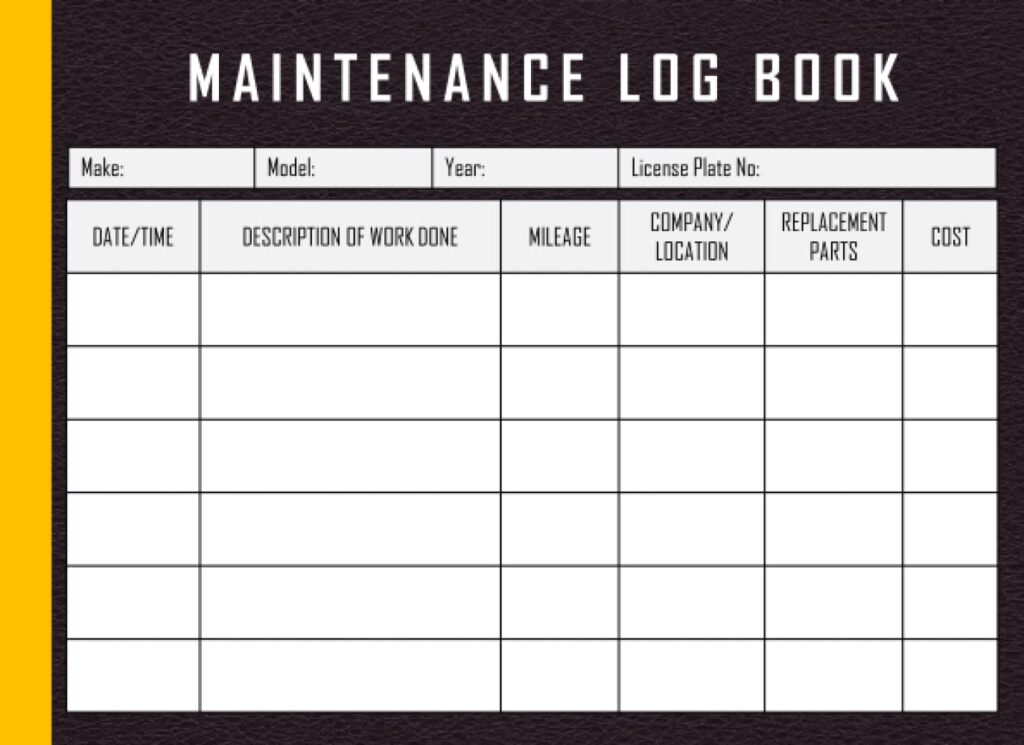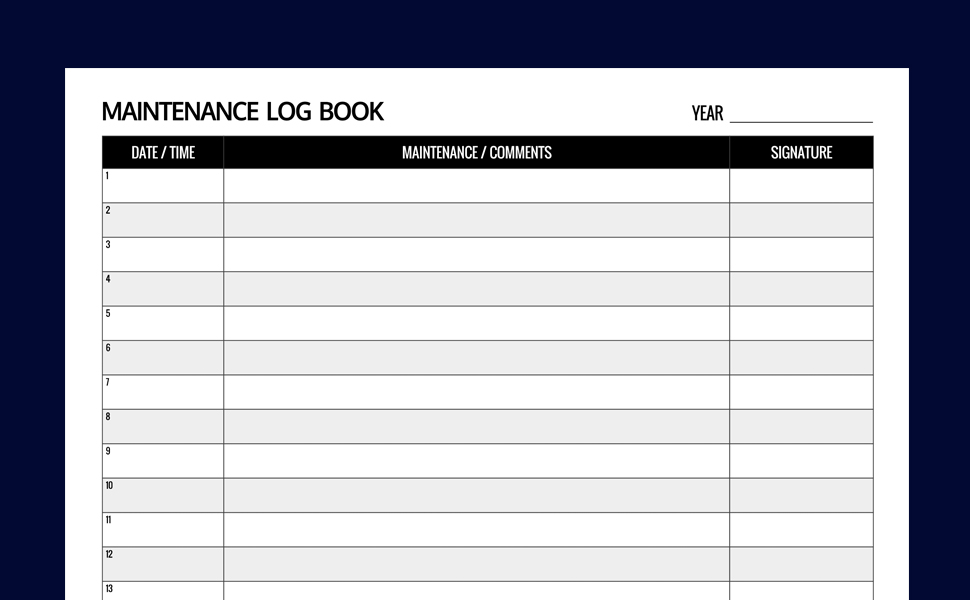The Essential Guide to Maintenance Log Book
Introduction
In industrial manufacturing, keeping operations running smoothly is a critical task. Downtime, inefficiencies, and unexpected breakdowns can significantly impact productivity and profitability. Therefore, a maintenance log book serves as an essential tool to minimize these disruptions. By tracking, analyzing, and planning maintenance activities, a log book helps ensure equipment reliability and optimal performance.
This guide is designed for professionals in the industrial manufacturing sector who want to learn the importance of maintenance log books, their key components, and best practices for using them effectively. By the end of this post, you will understand how to leverage a maintenance log book to enhance productivity and reduce unexpected downtime in your facility.

Why Maintenance Log Books Matter

Maintenance log books play a crucial role in the day-to-day operation of manufacturing facilities. They provide an organized and consistent record of all maintenance activities, from routine inspections to emergency repairs. As a result, by ensuring that all maintenance data is accurately recorded, log books facilitate better decision-making, reduce equipment downtime, and ultimately enhance operational efficiency.
The benefits are clear: maintenance log books allow maintenance teams to spot trends in equipment performance, predict potential failures, and establish a proactive maintenance culture. Consequently, this proactive approach helps to ensure that equipment is functioning optimally, extends the lifespan of machinery, and reduces repair costs. Therefore, the significance of a maintenance log book cannot be overstated—it is a vital tool for ensuring uninterrupted production, fostering accountability, and enhancing safety standards within the plant.
Key Components of a Maintenance Log Book

1. Asset Identification
To begin with, every log book should include specific details of each asset, such as its unique identification number, model, and location. This is critical for tracking the maintenance history of different equipment, which ensures that maintenance activities are tailored to each asset’s requirements. Moreover, clear asset identification allows technicians to quickly locate essential information about a machine’s service history, making diagnostics and repairs more efficient.
2. Maintenance Schedule
Another key component of a maintenance log book is the maintenance schedule. This is where routine maintenance tasks are documented, including the date and time of upcoming checks, inspections, and services. Regular scheduling ensures no activity is overlooked, thereby reducing the risk of unscheduled downtime due to equipment failure. Furthermore, a well-planned maintenance schedule helps keep assets in peak working condition and avoids costly breakdowns.
3. Detailed Maintenance Records
For each maintenance event, it’s important to document the details: what was done, by whom, when, and why. A detailed record captures the exact nature of the work completed, any parts replaced, the technician involved, and any observed issues. This ensures that maintenance actions are clearly communicated and traceable. In addition, detailed records also help create accountability and aid in future troubleshooting.
4. Condition Monitoring Data
A proactive maintenance strategy often relies on monitoring the condition of assets. Condition monitoring data, such as vibration levels, temperature, or pressure, should be included in the maintenance log book. Regular tracking of these data points allows for the early detection of anomalies that might indicate future equipment failure. Consequently, integrating condition monitoring data in a maintenance log book promotes predictive maintenance, which can reduce costs and avoid unexpected shutdowns.
5. Breakdown and Repair Analysis
Documenting breakdowns and repairs provides insights into the underlying reasons for equipment failure. A breakdown and repair analysis section in the log book helps identify repetitive failures, highlights problem areas, and provides a historical context for any patterns in equipment issues. Therefore, understanding the cause of breakdowns helps maintenance teams make informed decisions on whether to replace, upgrade, or adjust the maintenance approach for particular equipment.
6. Parts Inventory and Usage Tracking
An effective maintenance log book should also track parts inventory and usage. Maintaining an inventory record within the log helps ensure that technicians have quick access to information about parts in stock, thereby reducing the risk of delays due to unavailable spares. Additionally, it also helps identify parts that are frequently replaced, which might indicate underlying problems requiring a deeper examination.
Best Practices for Maintaining a Maintenance Log Book

1. Keep It Accurate and Up to Date
First and foremost, accuracy is the cornerstone of an effective maintenance log book. Maintenance data should be recorded immediately after the completion of a task. Keeping records up to date ensures that everyone has access to the latest information, which is critical for decision-making and planning future activities. Moreover, accurate data provides a reliable basis for analyzing trends and making informed improvements.
2. Use Standardized Terminology
Using standardized terminology when recording maintenance activities helps to avoid confusion and miscommunication. This is especially important in large facilities where multiple technicians are involved in maintenance. Consequently, standardization makes the log book easy to understand and ensures consistency, thereby improving the efficiency of the maintenance process.
3. Leverage Digital Maintenance Log Books
Digital log books offer numerous advantages over traditional paper log books. They are easy to update, searchable, and can be accessed by multiple stakeholders simultaneously. Furthermore, digital solutions also facilitate integration with other maintenance management systems, enabling more comprehensive data analysis and predictive maintenance planning. Therefore, embracing digital log books can make maintenance practices more efficient and data-driven.
4. Regularly Review and Analyze Records
A maintenance log book should not just be a record-keeping tool—it should be used actively to improve processes. Regularly reviewing and analyzing maintenance records helps identify trends, such as recurring issues with specific assets or areas where maintenance can be optimized. Insights drawn from these reviews can help improve preventive maintenance schedules and reduce unexpected failures.
5. Train Technicians on Proper Log Book Usage
Ensuring that technicians are trained on the importance of log books and how to use them properly is crucial for effective maintenance management. Training helps technicians understand what information needs to be recorded and why it is important. Therefore, when technicians know the value of accurate log-keeping, they are more likely to maintain high-quality records, ultimately contributing to improved asset reliability.
Common Challenges and Solutions
One common challenge with maintaining log books is human error—missing, inaccurate, or incomplete data. However, this can be mitigated by adopting digital log book solutions that include validation checks, automated reminders, and clear input fields.
Another challenge is ensuring technician compliance in maintaining log books. If technicians do not recognize the value of log books, they may overlook them. To address this, proper training and making the log-keeping process as straightforward as possible are essential. By highlighting the link between thorough log books and reduced stress during emergency repairs, technicians can better understand the importance of proper record-keeping.
A third challenge involves the time required to update log books, particularly when managing numerous assets. Therefore, digital solutions with mobile capabilities can simplify data entry by allowing technicians to record information directly from the work site. This eliminates the need for redundant paperwork and saves valuable time.
Conclusion
In conclusion, a maintenance log book is a foundational tool in the world of industrial manufacturing. Its ability to provide structured, comprehensive, and easily accessible records of maintenance activities makes it indispensable for maximizing equipment reliability and operational efficiency. By understanding and implementing the key components discussed in this guide, maintenance teams can significantly reduce unexpected downtime, ensure the safety of operations, and keep production running smoothly.
To make the most out of a maintenance log book, it’s important to keep records accurate, embrace digital solutions, and ensure that technicians are well-trained. By applying these best practices and addressing common challenges, you can ensure that your maintenance log book becomes a valuable asset in your journey toward achieving reliable and efficient manufacturing operations.
